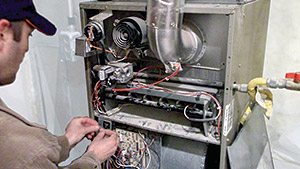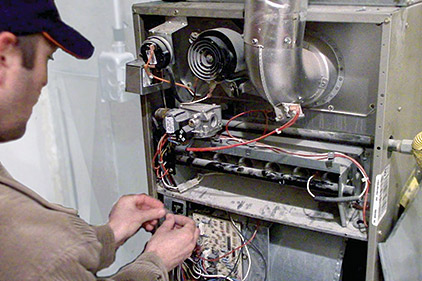
|
| Developing and implementing universal onboard diagnostics could help cut down on contractor error and improve overall system efficiency, said Glenn Hourahan, professional engineer and senior vice president at ACCA. (Photo courtesy of AdamDIY, http://youtu.be/5CDF0duucpQ) |
In an effort to make it easier for technicians to install, service, diagnose, and troubleshoot HVACR equipment, ACCA’s Board of Directors recently unanimously adopted a motion “to implore the manufacturers of HVAC equipment to develop and implement open [nonproprietary], universal, onboard diagnostic [OBD] communication protocols for HVAC equipment self-commissioning and ongoing diagnoses.” The board then asked the motion be presented to Air-Conditioning, Heating, and Refrigeration Institute’s (AHRI’s) Board of Directors for consideration at its November meeting.
“The HVACR industry does not have a universal system,” said Paul Stalknecht, president and CEO of ACCA. “We have individual proprietary systems offered by manufacturers, which makes it challenging for a contractor to diagnose and service equipment, especially when he goes to a new customer’s establishment. He doesn’t know, walking in, what equipment he will find from which manufacturer. The contractor today is looking for the tools to help in both field installation as well as the diagnostics to make sure they’re narrowing down precisely what the issue may be.”
Pushing for Standardization
Glenn Hourahan, professional engineer and senior vice president at ACCA, said the association’s initial goal is to encourage manufacturers to develop a common set of error codes that would be the same across all brands and equipment.
“What is the universal code?” Hourahan asked. “If I get error code XXXX, what does that mean? As an industry, we need to establish common error codes for low airflow, low refrigerant charge, high external static pressure (ESP), high duct leakage, etc. That’s not proprietary technology or information — that’s
just communication.”
Another goal, Hourahan said, is to develop a standardized access method, which could be either a universal connection port or a wireless connection. “It may not be a device you have to plug in,” he explained. “Likely, wireless may prove to be cost effective and provide additional benefits, such as supporting email or text message alerts to the contractor or building owner/operator saying there’s something wrong with the equipment.”
Stalknecht, who worked in the trucking industry for more than 20 years, compared truck engine diagnostics to HVAC equipment diagnostics when explaining why standardization is necessary.
“About 20 years ago, truck owners and maintenance shops were begging truck manufacturers to come together with some universal diagnostic tools so they could better service the industry and increase productivity and efficiency,” he said. “You heard a lot of outcry from a lot of the manufacturers that they couldn’t do it, or that they had their own proprietary systems. But, lo and behold, the customers’ voices became louder, and truck manufacturers came around to adopt universal protocols. Now, you can pull the truck into any certified shop and they’ll hook it up to a diagnostic machine that tells you what’s wrong with the equipment. And, you know what? Manufacturers found that their warranty exposures went down, and they obtained economies of scale when it came to addressing industry servicing issues.
“In the automotive and trucking industries, you connect a cable,” Stalknecht added. “You needed a universal port with a certain number of pins, and each pin gave a certain signal. Do manufacturers want to take that approach or go wireless? The approach would be different, but you still have to have consistency. Again, for HVACR applications, it’s not proprietary information — it’s coming together to say, ‘What’s the method we’re going to use?’”
Touting the Benefits
Developing and implementing universal onboard diagnostics could help cut down on contractor error and improve overall system efficiencies, Stalknecht said.
“Just last month, the National Institute of Standards and Technology [NIST] released a research report that verified deficiencies seen in the field can result in 30 percent or more energy inefficiency,” he explained. “Having smart diagnostics and smart communications that can help the technician know everything is well, or that something needs to be looked at, will go a long way toward improving equipment installations. It means we can continue to ensure the equipment is maintained and will continue to operate efficiently over the course of its life.”
According to an ACCA press release, additional benefits of developing and implementing universal communication protocols and diagnostic tools for HVACR equipment include:
• Improved ability to properly diagnose system problems the first time, limiting misdiagnosed equipment and reducing callbacks;
• Improved opportunities to provide better service/maintenance contracts through improved communications;
• Increased productivity through potential failure alerts and prognostics that identify potential failure points;
• Access to help for OEMs that require installation verification of their equipment (and subsequent warranty issues);
• Reduced service and installation costs for contractors through better and more reliable equipment/system information and analysis; and
• The ability to show potential next-generation workers that the industry embraces technology.
“There’s no reason whatsoever we don’t have this technology today,” Stalknecht said. “The only reason it doesn’t exist is because there are some manufacturers that use proprietary controls and communications to keep contractors locked into one brand. It causes inefficiency in the marketplace among contractors and manufacturers.”
Potential Concerns
Matt Lattanzi, director of product management at Nordyne, agrees universal onboard diagnostics “could be beneficial to contractors,” though developing and implementing universal onboard diagnostics will require time, effort, and money.
“Well-developed, standardized diagnostic tools that work with all equipment could benefit the industry by reducing the chance of misdiagnosis and the amount of technical training required to perform service functions,” he said. “That said, homeowners would most likely see higher equipment costs as a result of a universal protocol, especially in entry-level systems that currently do not contain advanced controls. Whether the benefits outweigh the costs will need to be carefully considered.”
Additionally, Lattanzi added, manufacturers are facing a record number of rulemakings from the U.S. Department of Energy (DOE) and U.S. Environmental Protection Agency (EPA), which also require manpower, time, and money to comply with.
“The current regulatory environment is very active, and managing new, mandated regulations requires many resources from a manufacturer,” Lattanzi explained. “Just think — since 2006, we’ve had to reconfigure and redesign equipment based on the 13 SEER efficiency regulation, the R-410A refrigerant regulation, and now the 14 SEER heat pump/packaged system national efficiency regulation and the 14 SEER air conditioner regional regulation. Adding the development and implementation of universal onboard diagnostics has the potential to delay product innovation or put critical regulatory compliance projects at risk. It doesn’t deter us from supporting the initiative, but it’s definitely a point worth considering.”
Lattanzi reiterated that Nordyne “is not opposed” to investigating a universal communication protocol. “We would not, however, support an initiative in this area that did not address the concerns identified by ACCA with respect to our desire to differentiate our products in the marketplace and encourage the use of qualified service technicians for equipment maintenance and repair.”
Industry Support
While some manufacturers and organizations are cautious about supporting the development of universal onboard diagnostics, others have thrown their full support behind it. The ClimateTalk Alliance, an organization of companies committed to developing a common communication infrastructure for HVAC and Smart Grid devices, has backed ACCA’s recent actions.
“The ClimateTalk Alliance completely agrees with the recommendation and hopes the AHRI Board of Directors will also consider action toward a common standard,” said Craig Johnson, president of the ClimateTalk Alliance Board of Directors. “This concept is core to our mission, and we welcome the support of ACCA as we work with our industry partners to enable innovative HVAC system solutions built on a common communication standard.”
Dick Foster, president of ZONEFIRST, a manufacturer of HVAC zone dampers and zoning systems, said the HVAC industry is lagging behind when it comes to communication protocols and needs to catch up. “When you look at the future, with things like the smart grid, everybody speaks to each other, but the HVAC industry doesn’t, and that’s a big issue,” he said. “It would be great for contractors to get a service call from the equipment … so when the technician goes out there, he knows exactly what to fix instead of having to try to troubleshoot. It’s good for the homeowner, as well. It kind of makes our industry more of a parts changer in some cases, but the more information we have on a problem, the better it is.”
Bill Alderson, corporate director of marketing for Rheem Mfg. Co., said ACCA “has valid reasons for urging universal communication protocols” among HVAC manufacturers and that Rheem “fully supports” developing diagnostics that help contractors more easily install new systems and quickly diagnose issues.
“The key to developing contractor- and consumer-friendly controls is embracing open standards,” Alderson said. “Rheem’s EcoNet communicating system provides the best capabilities of a manufacturer’s proprietary firmware while embracing the open standards of cloud-based communications.”
The Next Step
Stalknecht said the ball is now in AHRI’s court, so to speak. “The natural platform for that discussion to occur is at AHRI; AHRI does a tremendous job in setting standards and directions on behalf of equipment manufacturers,” he said. “That’s really the place where the discussion needs to be had, and that’s why we’re encouraging manufacturers to get together. I’d rather have the industry develop its own set of protocols instead of having the federal government or energy advocates design the system for us.”
Stephen Yurek, president and CEO, AHRI, said the organization is “aware of the ACCA board’s interest in establishing universal communication protocols” as well as the organization’s call for AHRI to vote on the issue at its Nov. 16 meeting.
“We are currently seeking input from the AHRI Smart or Connected Equipment Ad Hoc Committee, as well as from other appropriate AHRI committees and product sections, before making a recommendation to our board and executive committee,” Yurek said. “The ad hoc committee was created by the board to advise it and the product sections on communication protocol issues impacting our equipment. There currently are several proprietary protocols and open protocols available in the market today. Therefore, the selection of which protocol to use involves competitive issues. This is a good discussion to have, but we need to be mindful of market realities. For technical and anti-trust reasons, we need to move cautiously.”
Stalknecht said he is cautiously optimistic AHRI will support ACCA’s efforts, especially since several manufacturers and distributors have already expressed their support.
“The genesis of this whole movement came from the Joint Future Committee, which is a group of 25-30 individuals representing distributors, manufacturers, contractors, and interested stakeholders who identify pressing issues and concerns,” Stalknecht said. “The No. 1 issue that came out of the April 2014 meeting was the call for universal onboard diagnostics.”
Foster said now is the time to implement changes. “We have Wi-Fi, Bluetooth, ZigBee, Z-Wave — a plethora of communication protocols — but our industry is lagging well behind everybody when it comes to making everything interoperable,” he said. “It’s about time we got out there and started communicating. We’re not trying to tell you how to run things, but at least be able to communicate on that top level.”
Publication date: 11/10/2014
Want more HVAC industry news and information? Join The NEWS on Facebook, Twitter, and LinkedIn today!



Report Abusive Comment